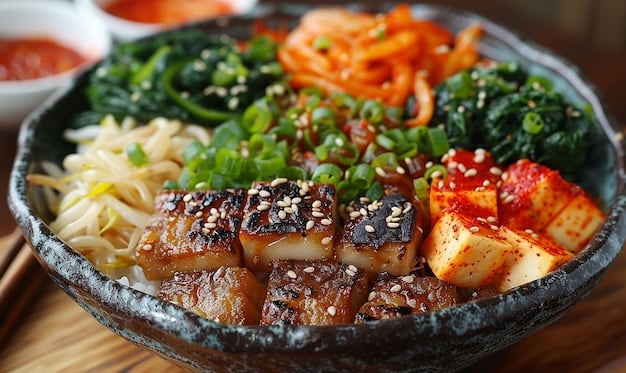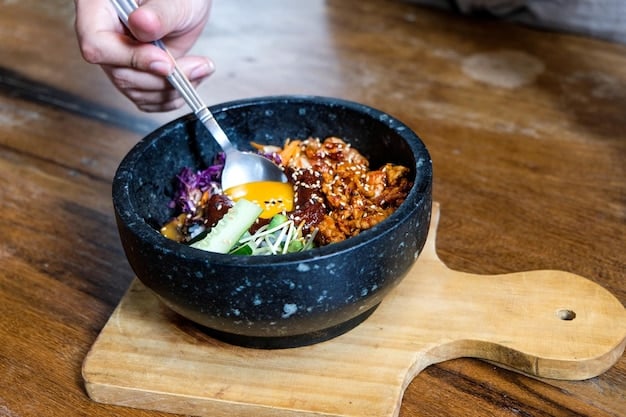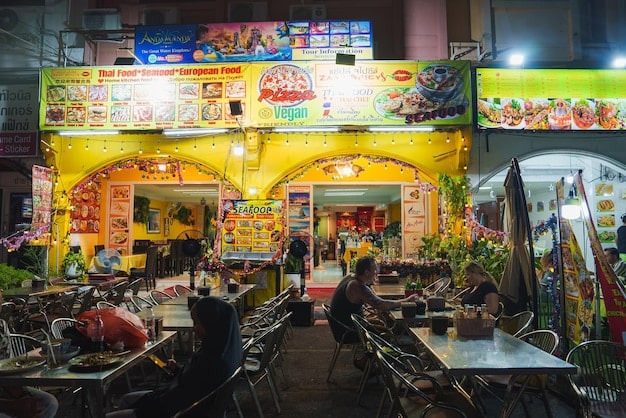The Use of Food as Metaphor in K-Dramas (2020-2025): A Culinary Review

The use of food as metaphor in K-dramas from 2020-2025 provides a rich lens through which to explore themes of love, family, social class, and personal growth, enhancing narrative depth and emotional resonance.
K-dramas have captivated audiences worldwide with their compelling narratives, stellar performances, and unique cultural insights. But beyond the surface-level entertainment, many K-dramas cleverly employ food as a powerful storytelling tool. Let’s delve into the use of food as metaphor in popular K-dramas from 2020 to 2025, exploring how culinary themes enhance the viewing experience.
Food as a Symbol of Love and Relationships
In K-dramas, food frequently serves as a potent symbol of love, affection, and the complexities of relationships. Sharing a meal, preparing a dish, or even the simple act of offering a treat can convey deep emotions that words often fail to capture.
The Language of Shared Meals
Shared meals are depicted as intimate moments where characters connect on a deeper level. The Korean tradition of communal dining emphasizes togetherness and strengthens bonds, making it a common motif in dramas exploring familial or romantic relationships.
Cooking as an Expression of Care
Characters who cook for others often use food as a way to express their feelings. The act of preparing a meal becomes a tangible demonstration of love, care, and sacrifice, especially when characters go out of their way to create something special for someone they cherish.
- Homemade kimchi symbolizes a mother’s unwavering dedication and love.
- A meticulously prepared lunchbox represents a romantic interest’s careful attention and affection.
- Sharing ramyun late at night portrays two characters getting closer.
Ultimately, these culinary gestures communicate a wealth of unspoken emotions, resonating deeply with viewers and enriching the narrative with layers of meaning.

Social Class and Culinary Disparities
Food is also used to highlight social class disparities within K-dramas, where the availability, quality, and presentation of food often reflect the characters’ socio-economic status. This theme can create powerful visual and emotional contrasts that underscore the inequalities present in society.
Food as a Marker of Privilege
Affluent characters in K-dramas often enjoy extravagant meals in luxurious settings, showcasing their privileged lifestyles. These scenes contrast sharply with those depicting less fortunate characters, who may struggle to afford even basic necessities.
The Struggle for Sustenance
Dramas frequently portray characters from lower social classes facing challenges related to food insecurity. These narratives highlight the daily struggles of individuals who must navigate economic hardship and make difficult choices to provide for themselves and their families.
- Scenes of rooftop residences, where food is scarce, contrast starkly with opulent penthouse dining experiences.
- The humble kimbap shop serves as a hub for characters facing financial hardships.
- Home-cooked meals showcase the resourcefulness of those who struggle to make ends meet.
By drawing attention to these culinary disparities, K-dramas offer social commentary, prompting viewers to reflect on the realities of economic inequality within their own societies.
Food as Comfort and Healing
In times of emotional distress or hardship, food often plays a comforting and restorative role in K-dramas. Certain dishes and culinary rituals can provide solace, evoking positive memories and fostering a sense of connection and healing.
Nostalgia and Childhood Memories
Specific foods can transport characters back to cherished moments from their past, offering a sense of familiarity and security. These nostalgic dishes often trigger fond memories of family and childhood, providing comfort during challenging times.
Culinary Rituals of Support
Offering food to someone who is grieving or struggling is a common gesture of empathy and support in K-dramas. Sharing food becomes a symbol of care and concern, conveying a message of solidarity and encouragement.
For instance, scenes featuring ramyeon become a common visual trope. The spicy noodles often consumed together represent not just caloric sustenance but also a sharing of vulnerabilities and fostering connections.
Food acts as a tangible expression of care and empathy that helps foster a sense of connection and community.
Food and Cultural Identity
Food plays a central role in representing cultural identity in K-dramas, showcasing the richness and diversity of Korean culinary traditions. From iconic dishes to traditional dining customs, food serves as a powerful symbol of national pride and heritage.
Showcasing Korean Cuisine
K-dramas provide a platform for showcasing a wide range of Korean dishes, introducing viewers to the unique flavors, ingredients, and preparation methods that define the nation’s culinary landscape. These visual feasts not only tantalize the senses but also offer valuable insights into Korean culture and history.
Preserving Culinary Traditions
Many dramas highlight the importance of preserving traditional culinary practices and recipes, emphasizing the cultural significance of passing down knowledge from one generation to the next. These narratives celebrate the dedication and expertise of individuals who strive to maintain authentic flavors and techniques.

Food transcends basic sustenance. Its presence embodies pride in Korean heritage and a celebration of cultural richness.
Character Development Through Culinary Experiences
Characters’ interactions with food, whether through cooking, eating, or sharing, often serve as a catalyst for personal growth and transformation in K-dramas. These culinary experiences can reveal hidden facets of their personalities, challenge their beliefs, and ultimately lead them on a path of self-discovery.
Culinary Skills as Empowerment
Characters who develop culinary skills often gain a sense of confidence and independence. The ability to create delicious and satisfying meals not only boosts their self-esteem but also empowers them to provide for themselves and others.
Food as a Mirror of Inner Turmoil
Characters’ eating habits and food preferences can reflect their emotional state and inner struggles. The way they approach food can reveal their anxieties, insecurities, and unresolved conflicts, providing valuable insights into their psychological complexities.
- A character struggling with isolation might be seen eating alone, with no joy or enthusiasm
- A chef might be viewed as someone who has everything under control. Food is a way to manage all of those aspects of life
Culinary Trends and Modern Interpretations
While K-dramas often celebrate traditional Korean cuisine, they also explore modern culinary trends and offer creative interpretations of classic dishes. These contemporary twists reflect the evolving tastes and preferences of Korean society, showcasing the dynamic nature of the country’s culinary scene.
Fusion Cuisine and Global Influences
K-dramas frequently feature fusion dishes that blend Korean flavors with international ingredients and techniques. These culinary innovations reflect the increasing globalization of Korean society and the growing appreciation for diverse culinary traditions.
The Rise of Food-Themed Dramas
The popularity of food-themed dramas has surged in recent years, with shows like “Let’s Eat” and “Wok of Love” capturing the hearts of viewers with their mouthwatering depictions of food and heartwarming stories. These dramas celebrate the joy of cooking, eating, and sharing meals with loved ones.
In summary, the exploration of culinary themes resonates deeply with viewers, enriching the viewing experience and inspiring them to appreciate the power of food in K-dramas.
Conclusion
In conclusion, the use of food as a metaphor in K-dramas from 2020-2025 serves as a powerful and versatile storytelling tool, enriching narratives with layers of meaning and emotional resonance. From symbolizing love and relationships to highlighting social class disparities, food helps illuminate the complexities of human experience. As K-dramas continue to captivate audiences worldwide, the use of food as metaphor will undoubtedly remain a cherished and integral element of their enduring appeal.
Key Aspects |
Brief Overview
🍲 Culinary Symbolism |
Explores how K-dramas use food to represent emotions and relationships.
🌏 Cultural Identity |
Showcases Korean cuisine and traditions, highlighting national pride.
⚖️ Social Disparities |
Reveals class differences through food availability and presentation.
💖 Comfort & Healing |
Depicts food as a source of solace and nostalgia during emotional distress.
Which K-dramas heavily feature culinary themes? ▼
Dramas like “Let’s Eat,” “Wok of Love,” and “Kim Bok Joo” prominently showcase food, using it to drive plot and develop characters.
How does food symbolize relationships in K-dramas? ▼
Sharing meals represents intimacy, cooking expresses care, and specific dishes evoke shared memories, strengthening bonds between characters.
What role does food play in portraying social class? ▼
Lavish meals signify affluence, while scarcity highlights economic hardship, creating visual contrasts that underscore social inequalities in K-dramas.
Why is food often associated with comfort and healing? ▼
Certain dishes trigger nostalgic memories and provide a sense of familiarity and security, offering solace during times of emotional distress and hardship.
How do K-dramas preserve and promote cultural identity through food? ▼
By showcasing Korean cuisine and traditions and highlighting the importance of passing down culinary knowledge, dramas celebrate and maintain authentic flavors.
Conclusion
Read more content





